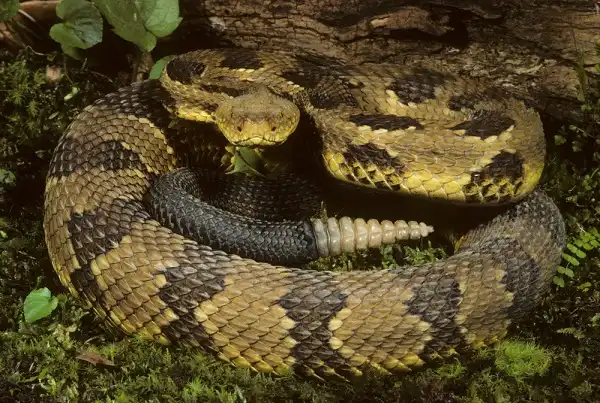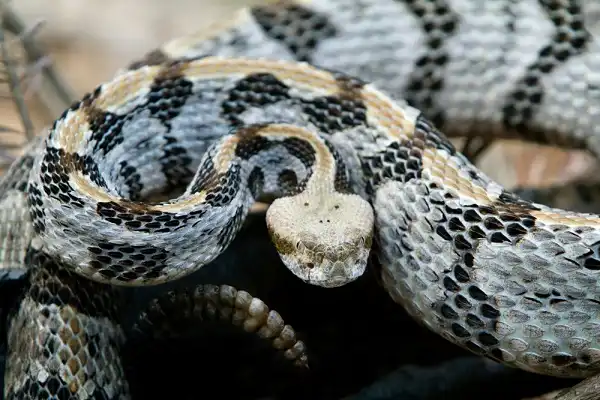When most people think of snakes, images of slender, slithering critters that belong in a terrarium come to mind. However, not all snakes fit this stereotype – some have adapted to live harmoniously amongst us in the wild. The Timber Rattlesnake is an example of one such species; these reptiles are integral members of natural ecosystems across forested regions throughout North America and can provide invaluable insights into their habitats when studied responsibly by researchers and enthusiasts alike. Read on for a deeper dive into the important role played by the Timber Rattlesnake within its native environment!

Timber Rattlesnake Description
Timber Rattlesnake, or Crotalus horridus, is a species of venomous snake native to the eastern and midwestern United States. Its coloring varies from yellowish-brown to grayish-black, often displaying a distinct pattern of black, brown, and yellow diamond shapes along its body. The species is favored by its ability to blend in with its environment due to this unique coloring pattern. They are also easily distinguishable by their namesake rattle at the end of their tail which helps protect the snake from predators.
Timber Rattlesnake Habitat
The Timber Rattlesnake is found in a variety of habitats throughout its range, from deciduous forests to rocky hillsides. They typically inhabit areas near rivers and streams, where they can hunt for prey or find shelter during cold weather. In the northern parts of their range, they are often found in mountainous regions while in the southern parts, they tend to live in lowland areas. The timber rattlesnake also prefers areas with plenty of rocks and crevices, as these provide ideal hiding places. Timber rattlesnakes are highly dependent on their environment for survival; thus, it’s important to consider their habitat when trying to protect their populations. Due to deforestation and human development, many of the rattlesnake’s habitats have been destroyed or degraded over time. As a result, certain species are now listed as endangered or threatened depending on where they live in North America. Conservation efforts such as creating protected areas or increasing public awareness can help ensure these species continue to thrive in their native habitats. Additionally, research initiatives into Timber Rattlesnake ecology are vital for gaining greater insights into how best to manage and protect them going forward. By understanding more about these species’ needs and behaviors, we can better equip ourselves to ensure that future generations will be able to appreciate this iconic reptile!
Timber Rattlesnake Diet
The Timber Rattlesnake is a carnivorous species that mainly feed on small rodents such as mice, voles, and squirrels. It will also feed on small birds or reptiles if available. They typically hunt in the evening and at night, using their thermal sensors to locate potential prey. During winter months they enter into a state of brumation where they remain inactive until warmer temperatures return in the springtime. When hunting, the rattlesnake will find a suitable spot and coil up to wait for their prey to appear. Once an animal passes by, the snake will quickly strike and inject venom with its curved fangs, killing the animal within minutes. The rattlesnake then swallows its meal whole and digests it over the course of several hours. In addition to preying upon smaller animals, Timber Rattlesnakes are also known to scavenge carrion if necessary. Although they prefer live animals as prey, these snakes will opportunistically feed on dead rodents or other creatures if food is scarce. Interestingly, research has shown that Timber Rattlesnakes can recognize whether an animal is alive or dead even before striking it!

Timber Rattlesnake Size
The Timber Rattlesnake is a large and impressive species of snake native to North America. They typically grow anywhere from three to 5 feet in length, although some specimens can reach up to 6 feet or more! The average weight ranges between 2 and 4 pounds, although large specimens can weigh up to 8 pounds. These snakes have wide triangular heads with distinct black or dark brown markings on their backs. When fully grown, Timber Rattlesnakes are often quite heavy for their size due to their thick muscular bodies. The tail ends in a rattle that vibrates when the snake feels threatened. This sound is created by interlocking segments of keratin that rub against each other when shaken, warning potential predators that they should stay away. Overall, these snakes are an amazing species worthy of respect and admiration due to their impressive size and unique traits. By understanding more about how they live in the wild we can better equip ourselves to ensure that future generations will be able to appreciate this iconic reptile!
Timber Rattlesnake Lifespan
The Timber Rattlesnake is a long-lived species, with adults typically living for 15 to 20 years in the wild. In captivity, these snakes have been known to live up to 25 years or more! Females reach sexual maturity between 5 and 7 years of age, while males reach maturity between 3 and 5 years old. The lifespan of Timber Rattlesnakes depends heavily on their environment; those living in climates with longer warm seasons tend to live longer than those living in colder climates. In addition to environmental factors, the size and health of an individual snake can also affect its longevity. Generally speaking, larger specimens tend to live longer than smaller ones. As such, it is important to provide proper nutrition and habitat conditions for your pet Timber Rattlesnake if you want it to remain healthy and happy for as long as possible!
Timber Rattlesnake Behavior
Timber Rattlesnakes are typically shy and reclusive creatures, spending much of their time in the safety of their dens. They are most active during the night, foraging for food or basking in the sun when temperatures allow it. When threatened, they will emit a loud rattle from their tails as a warning to potential predators that they should back away. Unlike many other species of snake, Timber Rattlesnakes are also known to be social animals who often bask together in large groups. These communal behaviors are thought to provide protection from predators, as well as aid in thermoregulation and courtship rituals. When confronted by predators, Timber Rattlesnakes may choose to employ one of two defensive strategies: either flee or fight. If a predator is too close or the snake is cornered, it may turn and strike aggressively with its fangs exposed; if given enough distance, however, it will typically flee the area in an attempt to escape danger. A curious behavior exhibited by these snakes is tongue flicking; this helps them sense their environment by gathering molecules from the air which can then be analyzed with their Jacobson’s organ. By using this form of chemical communication they can better hunt for prey or identify potential mates or sources of danger nearby.

Timber Rattlesnake Speed
The Timber Rattlesnake is not particularly fast compared to other snakes, with the average speed ranging from 0.5 to 2 miles per hour. However, it can move more quickly for short distances if necessary in order to escape predators or capture prey. These snakes have an adaptable locomotion technique that allows them to maximize their speed while still maintaining close contact with the ground – they will raise their mid-body off the ground while keeping the front and rear portions close to the surface. This way they can efficiently glide across most terrains without having to spend too much energy. Timber Rattlesnakes are also adept climbers and can move vertically up trees or rocks with ease in order to avoid potential predators or seek out food sources such as bird nests. They possess several adaptations that help them climb more efficiently, such as large scales on their bellies that provide traction when climbing upwards and small hooks along the edge of their tails which aid in gripping onto surfaces.
Timber Rattlesnake Hunting
Timber Rattlesnakes are adept hunters, utilizing their superb senses to locate prey. Their eyesight is highly developed and they can detect movement from up to 40 feet away. They also have an excellent sense of smell which is enhanced by their tongue-flicking behavior; this allows them to pick up chemical cues from the air that can help them identify potential food sources or predators. When hunting, Timber Rattlesnakes will often use a combination of ambush and active foraging strategies. During the ambush, they will lie in wait in areas where prey is likely to pass by – such as trails or game paths – and strike quickly when the opportunity presents itself. Alternatively, they may actively search for food using their keen senses, slowly wandering through their environment while looking out for signs of prey. In addition to traditional hunting techniques, Timber Rattlesnakes may also take advantage of scavenging opportunities if available. They have been observed eating carrion from dead animals or gathering around disturbed beehives looking for insects that have been forced out by the commotion caused by other animals.

Conclusion
The Timber Rattlesnake is an impressive and adaptable species that has managed to survive for thousands of years. This snake’s ability to move quickly, hunt effectively, and take advantage of a wide variety of food sources ensures that it can thrive in most environments. By understanding the various adaptations they possess and the behaviors they employ while hunting, we can better appreciate this iconic reptile and ensure that future generations will be able to experience it firsthand.
Frequently Asked Question


